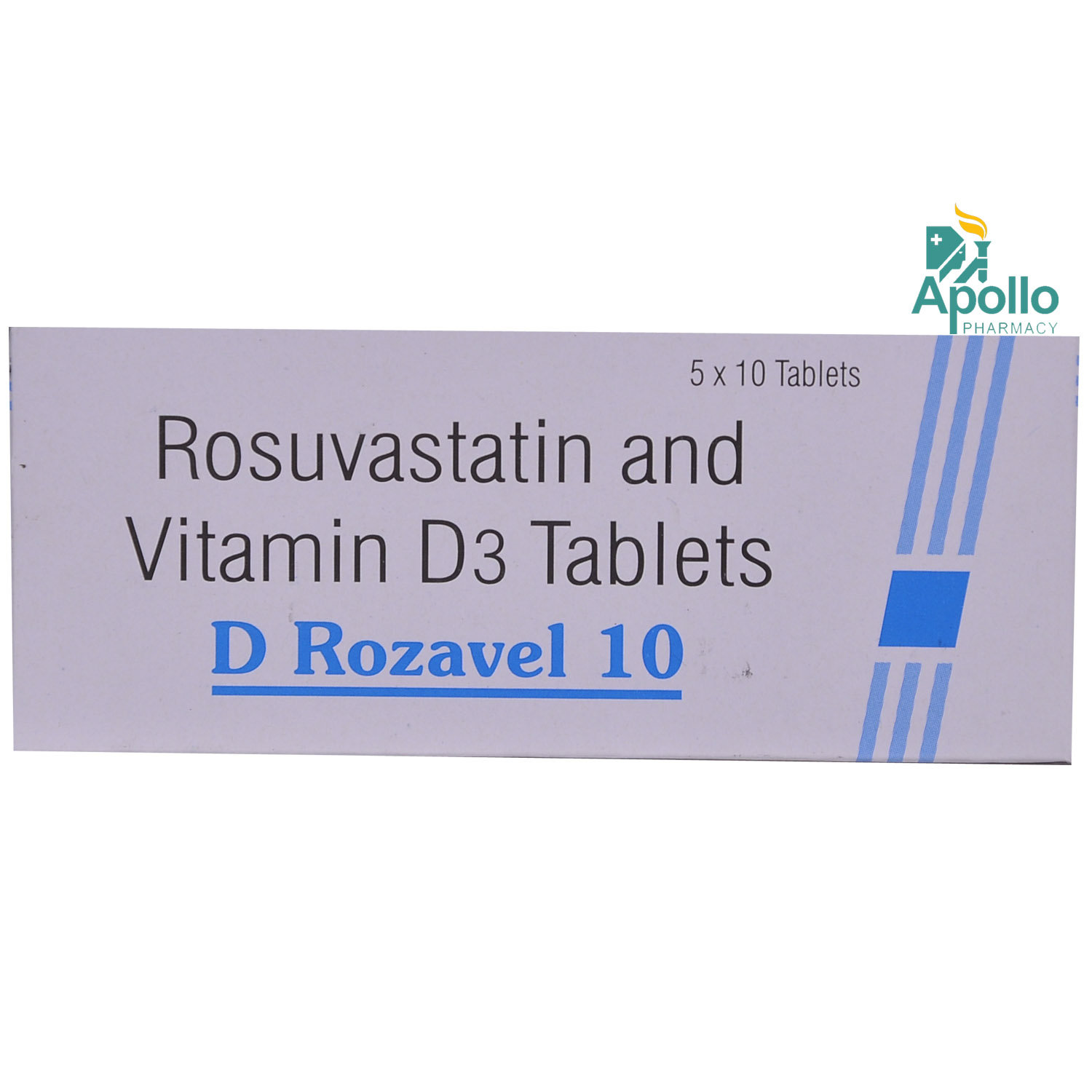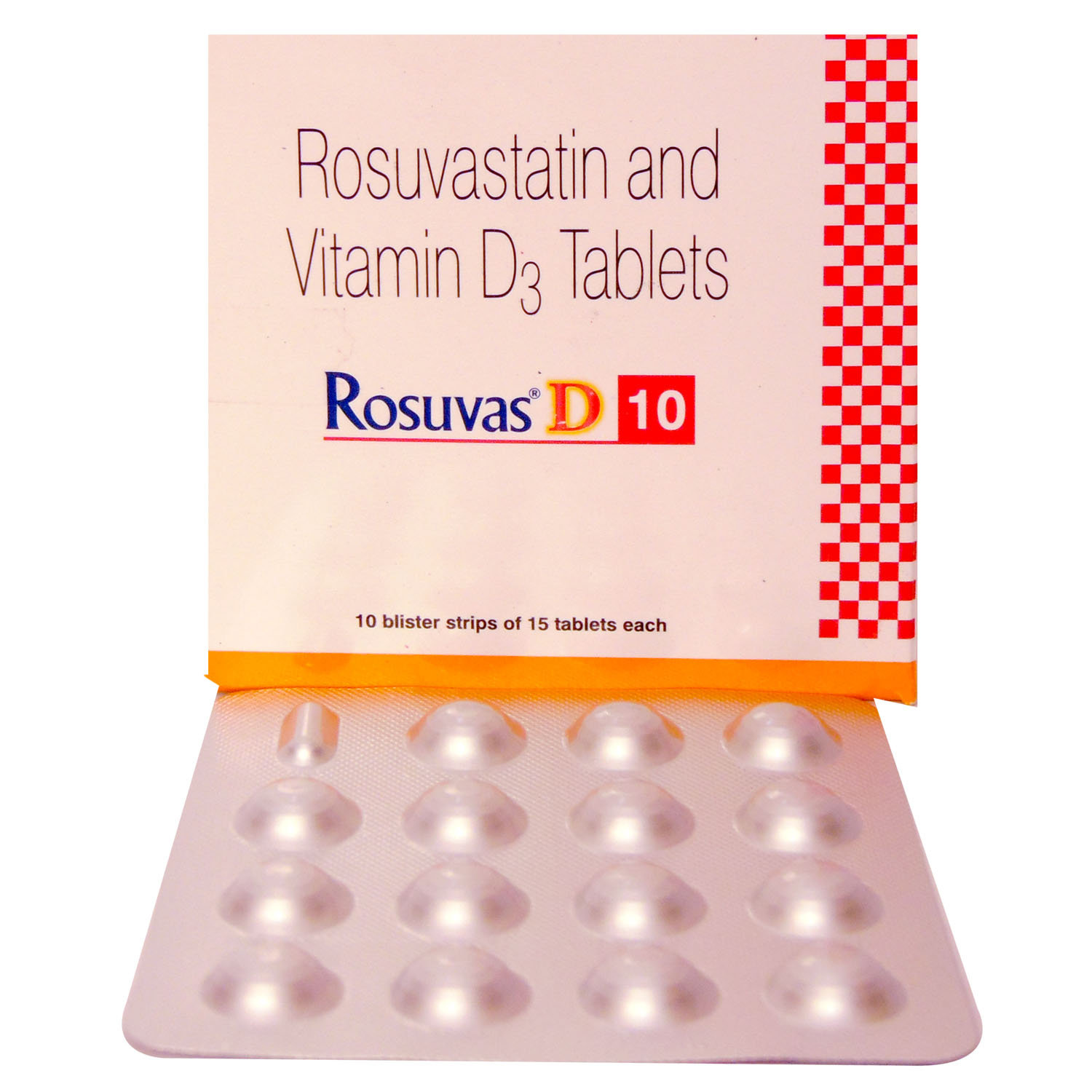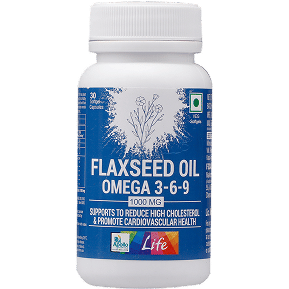ROSAVE D 10MG TABLET
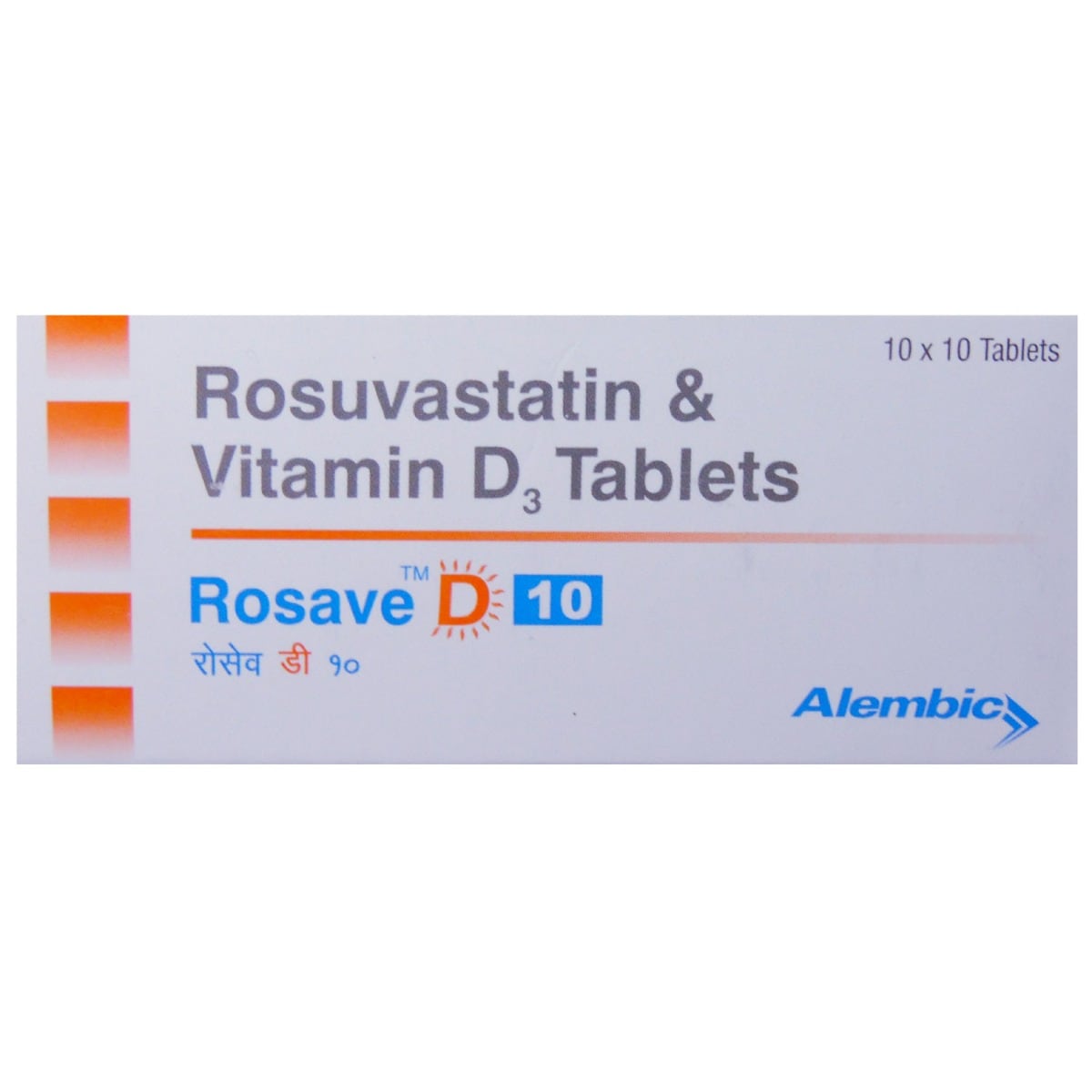
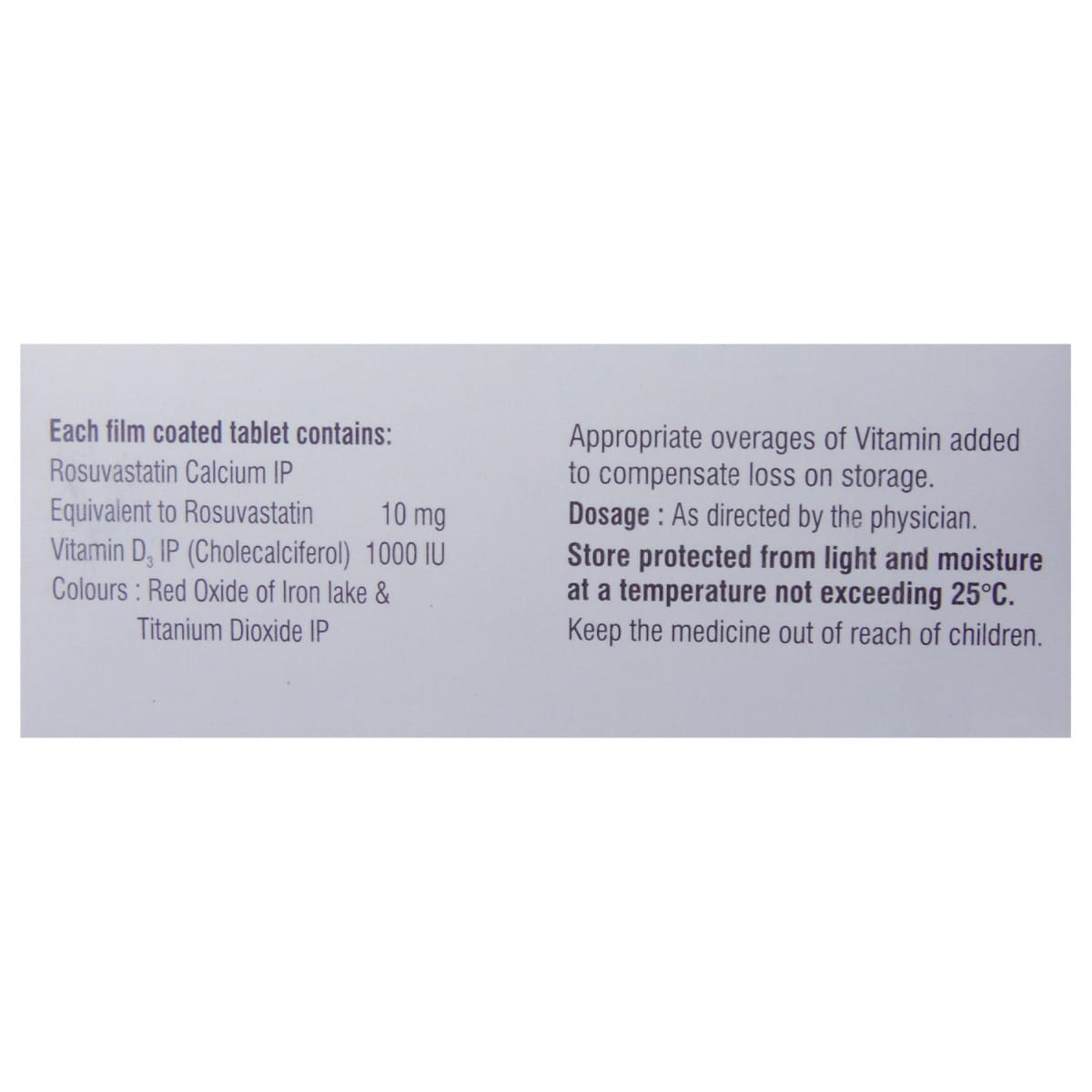
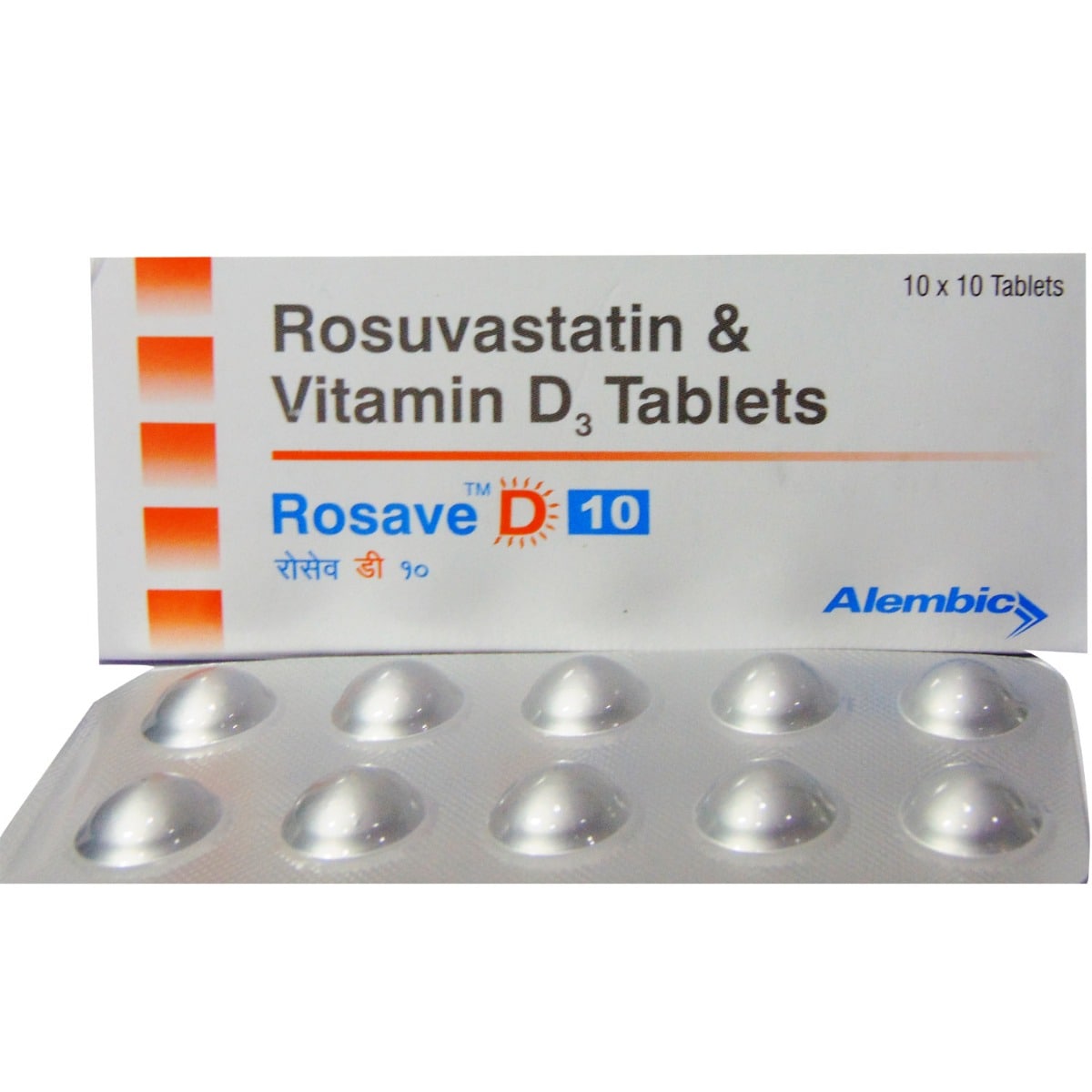
MRP ₹318
(Inclusive of all Taxes)
₹47.7 Cashback (15%)
know your delivery time
Provide Delivery Location
Composition :
Manufacturer/Marketer :
Consume Type :
Expires on or after :
Return Policy :

Secure Payment

Trusted by 8 Crore Indians

Genuine Products
Therapeutic Class
Country of origin
Manufacturer/Marketer address
Author Details
We provide you with authentic, trustworthy and relevant information
Disclaimer
Alcohol
Safe if prescribed
Avoid consumption of alcohol with ROSAVE D 10MG TABLET as it may increase the risk of liver damage. Please consult a doctor before consuming alcohol with ROSAVE D 10MG TABLET.
Pregnancy
Consult your doctor
ROSAVE D 10MG TABLET is a Category X pregnancy drug and is considered unsafe for pregnant women as it may cause harm to the unborn baby. So, if you are pregnant or planning for pregnancy, please inform your doctor before taking ROSAVE D 10MG TABLET.
Breast Feeding
Consult your doctor
Avoid breastfeeding while taking ROSAVE D 10MG TABLET as it may be unsafe for the baby. However, please consult a doctor before taking ROSAVE D 10MG TABLET.
Driving
Safe if prescribed
ROSAVE D 10MG TABLET usually does not affect your ability to drive or operate machinery. However, if you feel dizzy after taking ROSAVE D 10MG TABLET, avoid driving or operate machinery.
Liver
Consult your doctor
Please consult a doctor if you have any Liver diseases/conditions. ROSAVE D 10MG TABLET is usually not recommended in patients with liver disease.
Kidney
Consult your doctor
Take ROSAVE D 10MG TABLET with caution, especially if you have a history of Kidney diseases/conditions. The dose may be adjusted by your doctor as required. ROSAVE D 10MG TABLET is not recommended in patients with severe kidney problems.
Children
Safe if prescribed
ROSAVE D 10MG TABLET is not recommended for children below 6 years of age. However, ROSAVE D 10MG TABLET should be used with caution in children above 6 years if prescribed by a doctor.
Product Substitutes
About ROSAVE D 10MG TABLET
ROSAVE D 10MG TABLET belongs to the class of medicines called 'antilipemic' or cholesterol-lowering agent primarily used to lower raised cholesterol level. This reduces the risk of heart attack and stroke in future. High cholesterol known as hyperlipidaemia or dyslipidaemia occurs when there is an excess of the unhealthy balance of cholesterol in the blood. When the cholesterol level is high in the blood, your arteries get narrowed and clogged, contributing to heart diseases, like stroke and heart attack. Two cholesterol types are found in our body, namely, good cholesterol (high-density lipoprotein) and bad cholesterol (low-density lipoprotein). Good cholesterol is good for our heart and helps in reducing the bad cholesterol from our body. On the other hand, excess bad cholesterol (LDL) leads to the risk of heart diseases like heart attack and stroke.
ROSAVE D 10MG TABLET is a combination of two drugs: Rosuvastatin (statin) and Cholecalciferol (vitamin D3). Rosuvastatin belongs to the class of statins or HMG-CoA reductase inhibitors that work by inhibiting the HMG-CoA reductase enzyme in the body that is essential to make cholesterol. Thereby, it decreases the production of LDL (bad cholesterol) by the liver. Also, it reduces the risk of stroke or heart attack by reducing the excess cholesterol deposition in the major blood vessels of the brain and heart. Cholecalciferol is vitamin D3 that helps in the absorption of calcium by the body and also relieves muscle pain caused by Rosuvastatin.
Take ROSAVE D 10MG TABLET as prescribed. Your doctor will advise you how often you take ROSAVE D 10MG TABLET based on your medical condition. Some people may experience nausea, headache, stomach pain, dizziness, weakness, muscle pain or constipation. Most of these side effects of ROSAVE D 10MG TABLET do not require medical attention and gradually resolve over time. However, if the side effects persist, please consult your doctor.
If you are allergic to ROSAVE D 10MG TABLET or any other medicines, please tell your doctor. Avoid using ROSAVE D 10MG TABLET if you are pregnant or breastfeeding women and consult a doctor before taking ROSAVE D 10MG TABLET. You are advised to take effective birth control measures while taking ROSAVE D 10MG TABLET to avoid pregnancy while taking ROSAVE D 10MG TABLET. Avoid taking ROSAVE D 10MG TABLET if you have liver disease, including abnormal liver enzyme tests. You recommend maintaining a time gap of 2 hours between taking ROSAVE D 10MG TABLET and antacids containing magnesium or aluminium. Taking these medicines together may reduce the absorption of ROSAVE D 10MG TABLET by antacid. If you have thyroid disorder, severe respiratory failure, hypervitaminosis D (high levels of vitamin D in the body), hypercalcemia (high levels of calcium in the blood), electrolyte imbalance, kidney, liver, heart or muscle problems, please consult a doctor before taking ROSAVE D 10MG TABLET.
Uses of ROSAVE D 10MG TABLET
Medicinal Benefits Mweb
Key Benefits
ROSAVE D 10MG TABLET is a combination of two drugs, namely: Rosuvastatin and Cholecalciferol primarily used to lower bad cholesterol and triglyceride levels. Rosuvastatin belongs to the class of statins or HMG-CoA reductase inhibitors that work by inhibiting the HMG-CoA reductase enzyme in the body that is essential to make cholesterol. Thereby, it decreases the production of LDL (bad cholesterol) by the liver. Also, it reduces the risk of stroke or heart attack by reducing the excess cholesterol deposition in the major blood vessels of the brain and heart. Cholecalciferol is vitamin D3 that helps in the absorption of calcium by the body and also relieves muscle pain caused by Rosuvastatin.
Directions for Use
Side Effects of ROSAVE D 10MG TABLET
- Nausea
- Headache
- Stomach pain
- Dizziness
- Weakness
- Muscle pain
- Constipation
Drug Warnings
If you are allergic to ROSAVE D 10MG TABLET or any other medicines, please tell your doctor. Avoid using ROSAVE D 10MG TABLET if you are pregnant or breastfeeding women and consult a doctor before taking ROSAVE D 10MG TABLET. You are advised to take effective birth control measures while taking ROSAVE D 10MG TABLET to avoid pregnancy while taking ROSAVE D 10MG TABLET. Maintain a low-fat diet along with ROSAVE D 10MG TABLET for effective results. Avoid taking ROSAVE D 10MG TABLET if you have liver disease, including abnormal liver enzyme tests. You recommend maintaining a time gap of 2 hours between taking ROSAVE D 10MG TABLET and antacids containing magnesium or aluminium. Taking these medicines together may reduce the absorption of ROSAVE D 10MG TABLET by antacid. If you have thyroid disorder, severe respiratory failure, hypervitaminosis D (high levels of vitamin D in the body), hypercalcemia (high levels of calcium in the blood), electrolyte imbalance, kidney, liver, heart or muscle problems, please consult a doctor before taking ROSAVE D 10MG TABLET.
Drug-Drug Interactions
Drug-Drug Interactions
Login/Sign Up
Co-administration of Rosave D 10 Tablet with lenalidomide may increase the risk of a rare condition called rhabdomyolysis (breakdown of skeletal muscle tissue).
How to manage the interaction:
Although there is an interaction between lenalidomide and Rosave D 10 Tablet, it can be taken if prescribed by a doctor. However, if you experience muscle pain, tenderness, or weakness, consult the doctor immediately. Do not discontinue any medications without consulting a doctor.
Co-administration of Rosave D 10 Tablet and amprenavir can increase the blood levels of Rosave D 10 Tablet and can increase the risk of liver damage and rhabdomyolysis( breakdown of skeletal muscle tissue).
How to manage the interaction:
Co-administration of Rosave D 10 Tablet and Amprenavir can lead to an interaction, it can be taken if advised by your doctor. However, if you experience any symptoms like muscle pain, tenderness, weakness, dark-colored urine, fever, chills, joint pain or swelling, unusual bleeding or bruising, skin rash, itching, loss of appetite, fatigue, nausea, vomiting, and yellowing of the skin or eyes, consult the doctor immediately. Do not stop using any medications without a doctor's advice.
Co-administration of Rosave D 10 Tablet and Fenofibrate can increase the blood levels of Rosave D 10 Tablet and can increase the risk of liver damage and rhabdomyolysis(breakdown of skeletal muscle tissue).
How to manage the interaction:
Co-administration of Rosave D 10 Tablet and Fenofibrate can lead to an interaction, it can be taken if advised by a doctor. However, if you experience any symptoms like muscle pain, tenderness, weakness, dark-colored urine, fever, chills, joint pain or swelling, unusual bleeding or bruising, skin rash, itching, loss of appetite, fatigue, nausea, vomiting, and yellowing of the skin or eyes, consult the doctor immediately. Do not stop using any medications without a doctor's advice.
Coadministration of Nicotinamide with Rosave D 10 Tablet may increase the risk and severity of side effects like rhabdomyolysis (breakdown of skeletal muscle) or kidney damage which can be fatal.
How to manage the interaction:
Taking Nicotinamide with Rosave D 10 Tablet together can result in an interaction, but it can be taken if your doctor has advised it. If you notice any symptoms like unexplained muscle pain, muscle stiffness or tenderness, fever, dark-coloured urine, or weakness, you should contact your doctor immediately. Do not stop using any medications without first talking to your doctor.
Co-administration of Saquinavir and Rosave D 10 Tablet can increase the blood levels of Rosave D 10 Tablet and can increase the risk of developing liver damage and rhabdomyolysis(breakdown of skeletal muscle tissue).
How to manage the interaction:
Co-administration of Saquinavir and Rosave D 10 Tablet can lead to an interaction, it can be taken if advised by your doctor. However, if you experience any symptoms like muscle pain, tenderness, weakness, dark-colored urine, fever, chills, joint pain or swelling, unusual bleeding or bruising, skin rash, itching, loss of appetite, fatigue, nausea, vomiting, and yellowing of the skin or eyes, consult the doctor immediately. Do not stop using any medications without a doctor's advice.
Co-administration of Rosave D 10 Tablet and Darunavir can increase the blood levels of Rosave D 10 Tablet and can increase the risk of liver damage and rhabdomyolysis(breakdown of skeletal muscle tissue).
How to manage the interaction:
Co-administration of Rosave D 10 Tablet and Darunavir can lead to an interaction, it can be taken if advised by your doctor. However, if you experience any symptoms like muscle pain, tenderness, weakness, dark-colored urine, fever, chills, joint pain or swelling, unusual bleeding or bruising, skin rash, itching, loss of appetite, fatigue, nausea, vomiting, and yellowing of the skin or eyes, consult the doctor immediately. Do not stop using any medications without a doctor's advice.
Co-administration of Rosave D 10 Tablet and Atazanavir can increase the blood levels of Rosave D 10 Tablet and can increase the risk of liver damage and rhabdomyolysis( breakdown of skeletal muscle tissue).
How to manage the interaction:
Co-administration of Rosave D 10 Tablet and Atazanavir can lead to an interaction, it can be taken if advised by your doctor. However, if you experience any symptoms like muscle pain, tenderness, weakness, dark-colored urine, fever, chills, joint pain or swelling, unusual bleeding or bruising, skin rash, itching, loss of appetite, fatigue, nausea, vomiting, and yellowing of the skin or eyes, consult the doctor immediately. Do not stop using any medications without a doctor's advice.
Coadministration of colchicine and Rosave D 10 Tablet may increase the risk of conditions that affect your muscles and kidneys.
How to manage the interaction:
Taking Colchicine with Rosave D 10 Tablet may possibly result in an interaction, but they can be taken together if prescribed by your doctor. However, contact your doctor immediately if you experience abdominal discomfort, nausea, vomiting, diarrhea, back pain, weakness, or tingling or numbness in your hands and feet. Do not discontinue any medication without consulting your doctor.
Co-administration of Ritonavir and Rosave D 10 Tablet can increase the blood levels of Rosave D 10 Tablet.
How to manage the interaction:
Co-administration of Ritonavir and Rosave D 10 Tablet can lead to an interaction, it can be taken if advised by your doctor. However, if you experience any symptoms like muscle pain, tenderness, weakness, dark-colored urine, fever, chills, joint pain or swelling, unusual bleeding or bruising, skin rash, itching, loss of hunger, weakness, nausea, vomiting, and yellowing of the skin or eyes, consult the doctor immediately. Do not stop using any medications without a doctor's advice.
Co-administration of Simeprevir and Rosave D 10 Tablet can increase the blood levels of Rosave D 10 Tablet and can increase the risk of side effects like liver damage and rhabdomyolysis( breakdown of skeletal muscle tissue).
How to manage the interaction:
Co-administration of Simeprevir and Rosave D 10 Tablet can lead to an interaction, it can be taken if advised by your doctor. However, if you experience any symptoms like muscle pain, tenderness, weakness, dark-colored urine, fever, chills, joint pain or swelling, unusual bleeding or bruising, skin rash, itching, loss of appetite, fatigue, nausea, vomiting, and yellowing of the skin or eyes, consult the doctor immediately. Do not stop using any medications without a doctor's advice.
Drug-Food Interactions
Drug-Food Interactions
Login/Sign Up
Drug-Diseases Interactions
Drug-Diseases Interactions
Login/Sign Up
Drug-Drug Interactions Checker List
- GEMFIBROZIL
- FENOFIBRATE
- EZETIMIBE
- CYCLOSPORINE
- CLOPIDOGREL
- WARFARIN
- FUSIDIC ACID
- ERYTHROMYCIN
- DAROLUTAMIDE
- RITONAVIR
- LOPINAVIR
- ATAZANAVIR
- GLECAPREVIR
- PIBRENTASVIR
- PARITAPREVIR
- VELPATASVIR
- REGORAFENIB
- SOFOSBUVIR
- VOXILAPREVIR
- OMBITASVIR
- ELBASVIR
- DASABUVIR
- GRAZOPREVIR
Habit Forming
Special Advise
- Regular blood tests are recommended while taking ROSAVE D 10MG TABLET to monitor cholesterol levels in the blood and liver functioning.
- Regularly monitor blood sugar levels as ROSAVE D 10MG TABLET may increase the risk of developing diabetes, especially in patients who are overweight, have high blood pressure, or have high levels of fats and sugars in the blood.
Diet & Lifestyle Advise
- Maintain a low-fat diet. Limit your intake of dairy products made with whole milk and red meat. Prefer skim milk and fat-free or low-fat dairy products.
- Eat a healthy diet that includes fruits, vegetables, fish, poultry, whole grains, nuts and cut down beverages, and processed and sugary foods.
- Do regular exercises such as swimming, cycling, walking, or dancing and focus on losing weight as obesity also raises bad cholesterol and lowers good cholesterol.
- Avoid smoking and alcohol consumption.
All Substitutes & Brand Comparisons
RX
Out of StockROSUFIT D 10MG TABLET
Ajanta Pharma Ltd
₹85
(₹7.65 per unit)
73% CHEAPERRX
Out of StockROZUCOR D 10MG TABLET
Torrent Pharmaceuticals Ltd
₹181.1
(₹16.3 per unit)
43% CHEAPERRX
Out of StockZyrova D3 Forte Tablet 10's
Zydus Cadila
₹198.7
(₹17.88 per unit)
37% CHEAPER

Have a query?
Buy best Cardiology products by
Torrent Pharmaceuticals Ltd
Sun Pharmaceutical Industries Ltd
Lupin Ltd
Intas Pharmaceuticals Ltd
Cipla Ltd
Micro Labs Ltd
Macleods Pharmaceuticals Ltd
Abbott India Ltd
Ajanta Pharma Ltd
Ipca Laboratories Ltd
Eris Life Sciences Ltd
Mankind Pharma Pvt Ltd
Lloyd Healthcare Pvt Ltd
Dr Reddy's Laboratories Ltd
Glenmark Pharmaceuticals Ltd
Emcure Pharmaceuticals Ltd
Alembic Pharmaceuticals Ltd
Alkem Laboratories Ltd
East West Pharma India Pvt Ltd
USV Pvt Ltd
Zydus Healthcare Ltd
Aristo Pharmaceuticals Pvt Ltd
Elbrit Life Sciences Pvt Ltd
J B Chemicals & Pharmaceuticals Ltd
Zydus Cadila
Akumentis Healthcare Ltd
Alteus Biogenics Pvt Ltd
Hbc Life Sciences Pvt Ltd
Fusion Health Care Pvt Ltd
Troikaa Pharmaceuticals Ltd
La Renon Healthcare Pvt Ltd
Corona Remedies Pvt Ltd
Jubilant Lifesciences Ltd
Medley Pharmaceuticals Ltd
Knoll Healthcare Pvt Ltd
Msn Laboratories Pvt Ltd
Zuventus Healthcare Ltd
Cadila Pharmaceuticals Ltd
Blue Cross Laboratories Pvt Ltd
Lividus Pharmaceuticals Pvt Ltd
Morepen Laboratories Ltd
Ranmarc Labs
Shrrishti Health Care Products Pvt Ltd
Sanofi India Ltd
Steris Healthcare
Elder Pharmaceuticals Ltd
Primus Remedies Pvt Ltd
Unison Pharmaceuticals Pvt Ltd
Eswar Therapeutics Pvt Ltd
Knoll Pharmaceuticals Ltd
Tas Med India Pvt Ltd
Systopic Laboratories Pvt Ltd
Indiabulls Pharmaceuticals Pvt Ltd
Leeford Healthcare Ltd
Sinsan Pharmaceuticals Pvt Ltd
Biochem Pharmaceutical Industries Ltd
Cadila Healthcare Ltd
Azkka Pharmaceuticals Pvt Ltd
Nirvana India Pvt Ltd
Orsim Pharma
Prevego Healthcare & Research Pvt Ltd
Econ Healthcare
Elinor Pharmaceuticals (P) Ltd
FDC Ltd
Sunij Pharma Pvt Ltd
Nicholas Piramal India Ltd
Astra Zeneca Pharma India Ltd
Pfizer Ltd
Lia Life Sciences Pvt Ltd
Shine Pharmaceuticals Ltd
Elicad Pharmaceuticals Pvt Ltd
Indoco Remedies Ltd
Proqol Health Care Pvt Ltd
Vasu Organics Pvt Ltd
Biocon Ltd
Opsis Care Lifesciences Pvt Ltd
Johnlee Pharmaceuticals Pvt Ltd
Merck Ltd
Wockhardt Ltd
Auspharma Pvt Ltd
Ergos Life Sciences Pvt Ltd
Lakshya Life Sciences Pvt Ltd
Ordain Health Care Global Pvt Ltd
Pficus De Med Pvt Ltd
ALICAN PHARMACEUTICAL PVT LTD
RPG Life Sciences Ltd
Glynis Pharmaceuticals Pvt Ltd
Orris Pharmaceuticals
Samarth Life Sciences Pvt Ltd
Aprica Pharmaceuticals Pvt Ltd
Aretaeus Pharmaceuticals Pvt Ltd
Koye Pharmaceuticals Pvt Ltd
Neocardiab Care
Retra Life Science Pvt Ltd
Alniche Life Sciences Pvt Ltd
Alvio Pharmaceuticals Pvt Ltd
Arkas Pharma Pvt Ltd
Atos Lifesciences Pvt Ltd
Divine Savior Pvt Ltd
Metalis Lifesciences Pvt Ltd
Customers Also Bought
Recommended for a 30-day course: 3 Strips




